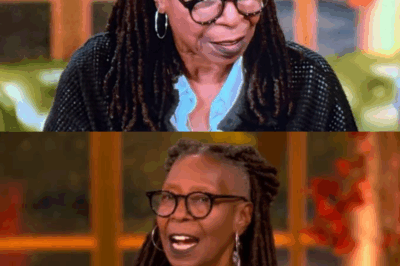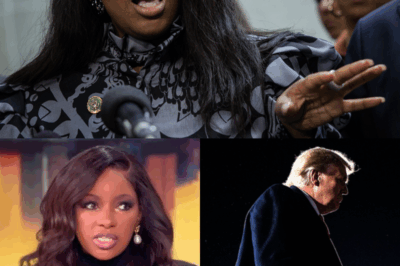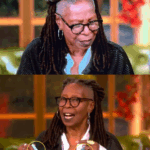Washington, D.C.—The Supreme Court chamber had never felt so charged. On this historic day, the air crackled with anticipation as legal scholars, veteran reporters, and ordinary citizens packed the gallery, all eager to witness a confrontation that had already begun to dominate headlines and social media feeds across the nation. The case at hand, Henderson v. Texas, promised to shape the future of voting rights in America, but what no one expected was the dramatic clash between two trailblazing women: Justice Sonia Sotomayor, the Court’s liberal conscience, and Congresswoman Jasmine Crockett, the rising star of Democratic politics.

Justice Sotomayor, at 70, is a formidable figure in American jurisprudence. Appointed by President Obama in 2009, she is the first Latina to serve on the Supreme Court, renowned for her incisive questioning and passionate dissents on issues ranging from voting rights to immigration. Her journey from the South Bronx to Princeton, Yale Law, and ultimately the highest court in the land is the stuff of American legend. For over a decade, she has been the Court’s voice for the marginalized, unafraid to challenge both her colleagues and the legal establishment.
Facing her was Congresswoman Jasmine Crockett, 43, representing Texas’s 30th Congressional District. Crockett’s meteoric rise from public defender to national political figure has been marked by her fearless committee performances and viral moments on social media. With a background as a civil rights attorney, Crockett entered the Supreme Court not just as a politician, but as an advocate intimately familiar with the struggles of ordinary Americans.
The stakes for Henderson v. Texas could not have been higher. The Court’s decision would determine whether states could redraw congressional districts in ways that might disenfranchise millions of minority voters. As a member of the House Judiciary Committee, Crockett had been granted the rare privilege of presenting oral arguments alongside Department of Justice lawyers—a move seen by some as a publicity stunt, by others as a necessary evolution in the relationship between Congress and the judiciary.
From the moment Crockett entered the chamber, it was clear this would not be a typical Supreme Court session. Dressed in a deep navy suit, she exuded confidence without ostentation. As Chief Justice Roberts called the session to order, the traditional formalities barely concealed the tension humming beneath the marble columns.
Crockett began her argument with a steady, resonant voice: “Your honors, I stand before you not just as a member of Congress, but as someone who has witnessed firsthand how the issues in this case affect real people in real communities.” The justices listened, some with skepticism, others with curiosity. But it was Justice Sotomayor whose reaction was the most telling—her jaw tightened, her fingers drummed against the bench, a subtle sign of disagreement for those who knew her well.

As Crockett wove stories of voters from her district—those disenfranchised by gerrymandering, communities split apart by partisan redistricting—the questions from the bench grew sharper. Justice Kavanaugh challenged her interpretation of precedent. Justice Gorsuch pressed her on federalism. But Crockett stood her ground, citing case law and constitutional principles with the poise of a seasoned litigator.
Then came the moment that would reverberate far beyond the courtroom. Justice Sotomayor, her voice sharp, cut through the chamber: “Congresswoman Crockett, this court is not a political forum. We deal with law, not anecdotes. Your role here is to present legal arguments based on constitutional interpretation and precedent. Personal stories and political advocacy have no place in these proceedings.”
The silence that followed was electric. Even the court stenographer looked up, sensing the gravity of the rebuke. For a brief second, it seemed Crockett might falter under the weight of public correction from one of the nation’s most respected jurists. Instead, she smiled—a confident, unflinching smile.
“With the greatest respect for this court and your distinguished service, I have to disagree,” Crockett replied, her voice calm yet resolute. She stepped closer to the podium, her posture straightening. “Wasn’t it personal stories that shaped this court’s greatest decisions? The story of Linda Brown in Brown v. Board, Dolores Gideon in Gideon v. Wainwright? Justice Sotomayor, your own confirmation hearings were filled with stories about your life, your family, your experiences. Were those stories irrelevant to your fitness for this court?”
The chamber held its collective breath. Crockett pressed on, invoking the oath she took as a member of Congress to support and defend the Constitution. “When you tell me that the stories of my constituents don’t matter in constitutional interpretation, you’re not just silencing me, you’re silencing them.”
Justice Sotomayor’s face was unreadable, but her knuckles whitened as she gripped her pen. The exchange had shifted from legal sparring to a fundamental debate about the role of the judiciary in a democracy. Crockett’s argument was clear: the law cannot be divorced from the lives it affects.
Justice Sotomayor, regaining her composure, asked pointedly, “Are you suggesting that this court’s commitment to constitutional law should be subordinated to popular sentiment?” It was a trap—answer yes, and Crockett would be accused of advocating mob rule; answer no, and she would undermine her own argument.
But Crockett was ready. “I’m suggesting that constitutional law that ignores the real-world impact on American citizens isn’t constitutional law at all. It’s academic theory divorced from reality. This court’s legitimacy comes from serving the people, not standing apart from them.”
The justices, the gallery, even the Chief Justice, sat transfixed. Crockett concluded by addressing Sotomayor directly: “You’ve shown that diversity of experience strengthens this court. If personal experience matters for justices, why doesn’t it matter for the people whose lives are affected by your decisions?”
For a long moment, Sotomayor was silent. When she finally spoke, her voice was softer. “Congresswoman Crockett, you’ve given this court much to consider. Perhaps the question isn’t whether personal stories belong in constitutional interpretation, but how we balance individual experiences with legal principles.”
The impact was immediate and profound. Legal commentators and scholars erupted on social media, hailing the exchange as one of the most significant in recent memory. Progressive leaders praised Crockett’s courage; even her critics acknowledged her masterful advocacy. The Supreme Court’s own YouTube channel saw millions of views as Americans tuned in to watch the confrontation.
In the days that followed, the debate spread far beyond legal circles. Law schools began incorporating the exchange into their curricula. The National Bar Association commended both women for demonstrating that respectful disagreement can elevate constitutional questions. Even Justice Sotomayor, speaking at a judicial conference days later, acknowledged the importance of humility and the need for the Court to remain connected to the people it serves.
Jasmine Crockett’s performance transformed her from rising star to national figure, inspiring a new generation of lawyers and civic leaders. Her message was clear: institutional respect does not require silence. And Justice Sotomayor’s willingness to listen, to reconsider, and to engage in genuine dialogue showed that judicial wisdom includes the humility to learn from criticism.
In a time of polarization and institutional distrust, the confrontation between Sotomayor and Crockett offered a rare glimpse of how powerful leaders can disagree—respectfully, passionately, and productively—while strengthening the very foundations of American democracy. The echoes of that day will be felt for years to come, a reminder that in a true democracy, no institution is above the voices of the people it serves.
News
💔 “SHE DIDN’T PLAN TO BE A HERO — SHE JUST COULDN’T WALK AWAY.” 🌧️ When Rachel Maddow landed in Jamaica to cover the aftermath of Hurricane Melissa, she expected devastation. What she didn’t expect… was her. A little girl, barefoot in the wreckage, clutching a soaked teddy bear and whispering one word: “Mama.” Reporters looked away. Cameras kept rolling. But Maddow — silent, trembling — stepped forward. That night, she stayed. Days later, she signed the papers that changed both their lives forever. Now, as the world reacts to her unexpected act of love, one haunting question remains: Was this journalism… or destiny?|KF
1. The Storm That Took Everything The storm had no mercy. Hurricane Melissa tore through Jamaica with winds that howled…
😱 “NO CAMERAS. NO PRESS. JUST ACTION.” 💥 When Hurricane Melissa left Jamaica in ruins, everyone expected statements — not silence. But that night, Rep. Jasmine Crockett made a call no one knew about. Hours later, a private shipment — blankets, medicine, and water filters worth $500,000 — quietly left U.S. soil. No press release. No credit. Just a note inside the first box that made rescuers burst into tears. Now, the world wants to know: what did she write?|KF
When Hurricane Melissa finally loosened its grip on Jamaica, what remained was not silence but the faint hum of survival…
💥 “THE TAPES WERE NEVER MEANT TO LEAVE THE BUILDING.” 😳 A Turning Point USA insider has come forward — and what they just leaked about Erika Kirk and the Chief of Staff is sending shockwaves through conservative media. Behind closed doors, secret recordings. Late-night meetings. Deleted emails that someone thought were gone forever. And now, the story is unraveling — faster than anyone can contain it. The insider’s confession doesn’t just expose one scandal… it hints at a network of cover-ups stretching far beyond TPUSA. 👀 Either way, the receipts are coming — and they could change everything. 👉 Full leaked details in the comments (CMT) before they disappear… 🔥👇👇|KF
Late last night, an anonymous insider from Turning Point USA (TPUSA) dropped a bombshell that has sent shockwaves through conservative…
“LIVE MELTDOWN ON NATIONAL TV” — WHOOPI GOLDBERG’S EXPLOSIVE MOMENT LEAVES ‘THE VIEW’ IN CHAOS 😱💥 It started like any other morning at The View. Laughter. Headlines. Controlled chaos. Then — a single note changed everything. As producers slipped Whoopi Goldberg a message mid-segment, cameras caught something no one was supposed to see. With a glare sharper than a knife, she snatched the paper, ripped it to pieces, and tossed it aside — live, unedited, and on national television. The studio froze. Her co-hosts went silent. Viewers at home could feel it — that thick, electric tension pulsing through the screen|KF
Inside Whoopi Goldberg’s Live Meltdown — and the Crisis Shaking Disney’s Daytime Empire It started with a folded piece of…
💥 “NO CAMERAS. NO PRESS. JUST THREE NAMES THE WORLD THOUGHT THEY KNEW.” 🌪️ When the Category-5 monster Hurricane Melissa tore through Jamaica, help was nowhere in sight. Then — without a single announcement — a private jet touched down at dawn. Inside: Rachel Maddow. Stephen Colbert. Joy Reid. No sponsors. No cameras. No entourage. They brought 5 tons of food, medicine, water filters, and $1.5 million in aid, all paid from their own pockets. Locals said they worked through the night — lifting boxes, feeding children, treating wounds — not a single word about fame or press. And when a volunteer asked why they came, Joy Reid quietly answered: “Because the news doesn’t need to cover this — humanity does.” By morning, they were gone. No selfies. No headlines. Just whispers spreading across the island — “Were those really them?” Nobody knows who leaked the flight manifest. But one thing’s certain: this wasn’t charity. This was rebellion — against the silence of comfort. 🕯🌎 👇 Full uncovered story before it disappears…|KF
No cameras. No sponsors. Just three journalists who decided to act, not speak. When Hurricane Melissa struck Jamaica — the…
End of content
No more pages to load












